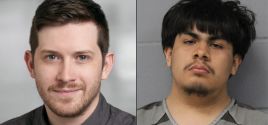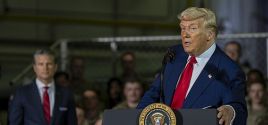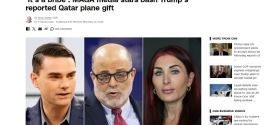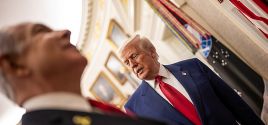Spy leaves egg on U.S. facesBook says Mohamed engaged in terrorism for two decadesBy THANE BURNETT Toronto Sun Nov. 22, 2006 |
Popular 
Eloy Adrian Camarillo, 17, Arrested in Shooting Death of Infowars Reporter Jamie White

NYT: Trump Ended War With Houthis After They Shot Down U.S. Drones, Nearly Hit Fighter Jets

Ben Shapiro, Mark Levin and Laura Loomer Warn of Foreign Influence... From Qatar

Report: Hamas Says Witkoff Promised to Lift Gaza Blockade in Exchange for Edan Alexander

Trump Advisor to Washington Post: 'In MAGA, We Are Not Bibi Fans'
 Those who want a chilling account of a killer who slipped through the hands of a daft justice system shouldn't bother to read the tripe now being peddled by O.J. Simpson. As a murderer, his record of terror just can't compare with Ali Mohamed. How the al-Qaida superspy manipulated FBI intelligence watchdogs, as well as one of America's most respected U.S. attorneys, is a chilling bedtime story. Those few people who still believe the West has been told all there is to know about intelligence bungling that led up to 9/11 -- a recent poll found 80% of Americans think their administration is not being fully truthful -- should trace the blood-timeline of Ali Mohamed with utter alarm. Which is what Peter Lance (peterlance.com) -- an Emmy-award winning investigator -- has done in his book, Triple Cross. The 600-plus-page opus -- released by Regan publishing next week but given an exclusive Canadian advance here -- is a detailed account of how Mohamed worked worry-free under the gaze of U.S. watchdogs. In the al-Qaida camps, he was known as Abu Mohamed al Amriki -- "Father Mohamed the American." And, until he was finally arrested and convicted in 2000 -- after two decades of high profile terrorism, including helping to plan attacks on American troops in Somalia and U.S. embassies in Africa -- Ali Mohamed roamed free and even protected. SUSPECTED THREAT He was so untouchable, he was taken from quick-thinking Canadian officials, who suspected he may have been a threat. In the most intimate and thorough way possible, Triple Cross chronicles one of the most vicious spies of our time. Mohamed was a U.S. Army sergeant, FBI operative and possible CIA asset, who, on the side, was a friend to Osama bin Laden, trained the leader's bodyguards, was instrumental in killing Americans and was the middle-man in an historic and vile union between bin Laden's forces and the Lebanese Hezbollah. His fingerprints can be traced to those who assassinated Jewish militant Meir Kahane and blew up the first truck bomb to hit the World Trade Centre. He made no real secret about being a die-hard jihadi. But the U.S. refused to accept him for what he really was. "In the annals of espionage, few men have moved in and out of the deep black world between the hunters and the hunted with as much audacity as Ali Mohamed," Lance, a former ABC News producer, writes in his book. Mohamed worked his triple-cross as U.S. authorities were -- Lance argues -- distracted with inner-politics, their own lives, the mob and even a horiffic murder. But more than he does with anyone else, Lance points an accusing finger at celebrated U.S. attorney Patrick Fitzgerald, who directed the FBI's elite bin Laden squad, which, Lance argues, allowed Mohamed to remain an active al-Qaida agent. Lance writes Fitzgerald and other top officials ignored important al-Qaida-related evidence, including proof in 1996 of a liquid-based airliner bomb -- a precursor to last August's plot revealed by British intelligence. Lance pinpoints how, in 1991, the FBI, knowing of a New Jersey mail box store with direct links to al-Qaida, failed to keep it under watch. Just six years later, two of the 9/11 hijackers got their fake IDs at the same location. Mohamed himself had come to the FBI's attention in 1989, when the agency's Special Operations Group photographed a cell of his trainees firing AK-47s at a Long Island shooting range. The bureau would drop that investigation -- as it would in many other cases involving the terror spy. It would also keep him safe. Even in Canada. Lance connects all the dots, including how Mohamed came, in 1993, to be questioned by suspicious RCMP officers in Vancouver. Lance says he was set free after handing the RCMP a phone number that connected them with his FBI handler. "The Canadians placed the call," Lance writes. "Whatever (the special FBI agent) said, caused the Mounties to let Mohamed go... . Al-Qaida's master spy was free." The incident happened when Mohamed -- a Californian of Egyptian origin -- went to Vancouver International Airport to check on Assam Marzouk. Marzouk, also an Egyptian who's now in prison there, arrived from Damascus with two forged Saudi passports. The RCMP scooped him up. TESTIFIED Mohamed would even come back to testify in Marzouk's refugee hearing. Mohamed was perhaps the highest ranking al-Qaida member to walk the streets of Canada and show up to help get another terrorist free. "I don't blame the RCMP -- they were doing what they were supposed to be doing," Lance tells me, while on the phone from California. "They were counting on the FBI. "(But) if the RCMP had their way and perhaps held onto Mohamed back then...the 224 people who lost their lives in (1998 terrorist attacks) in Kenya and Tanzania...might still be alive. That's my opinion, but you can quote me on it." Lance, who wrote two previous best-selling FBI investigative books -- 1,000 Years for Revenge and Cover Up -- is so detailed that Cover Up led to an indictment of second-degree murder being brought against a former FBI agent. This time, he continues to put the federal bureau -- and the system that continues to watch over North America -- on trial. If you want to stay awake at night, don't bother looking to O.J. Simpson, who wants to live life around two past murders. Look to the case of Ali Mohamed, who once boasted of having hundreds of sleeper cells at his command. Yet, not one of them has ever been uncovered. |



